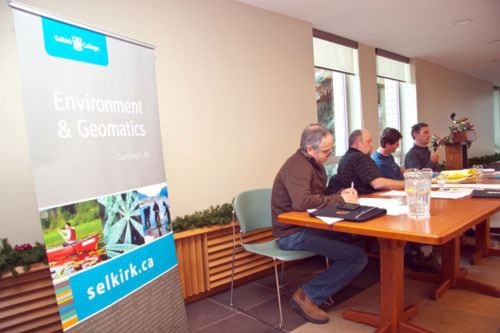The Kootenay forestry community gathered on Thursday, Dec. 1 at Selkirk College Castlegar campus to discuss how the forest industry and communities can work together more effectively, as part of the province-wide Healthy Forests – Healthy Communities initiative.
About 60 people attended the dialogue, which was hosted by Selkirk College’s School of Environment and Geomatics, including students, forest industry professionals and members of the general public.
The event started out with a talk on the importance of communities in forest management by semi-retired registered professional forester (RPF) and Mayor of Kaslo, Greg Lay, and then moved on to a panel discussion by three people with plenty of on-the-ground experience in the industry: Brent Petrick an RPF for 10 years and small woodlot owner; Stan Hadikin, woodlands manager at Kalesnikoff Lumber and Jesper Neilsen, manager of the Nakusp Community Forest.
The panellists discussed big questions around the forest industry’s relationship to communities, such as: Why should the community be interested in forest management practices? Are communities currently involved in forest management? And, if not, what tools exist to facilitate community involvement in forest management?
While each panellist offered up his own perspectives on how to get communities involved in forest management, they generally agreed that residents of communities in the Kootenays have to be involved in their forests because forests play such significant roles in communities – both from an economic perspective and in terms of recreation and safety.
Suggestions for engaging communities in forest practices included more education, recognition of changing societal values and panels of community members who oversee forest practices, much as school board trustees oversee management of schools in the region.
As the forum moved on to small group discussions, education came to the forefront of many groups – specifically education about the forests and forest practices from an early age, so people will be more knowledgeable and aware of the forests around them and thus take a greater interest in forest management throughout their lives.
Shorter-term solutions proposed to get people engaged included: using technologies such as Google Earth that allow people to explore geographies at the click of a mouse; finding champions of forestry in communities who can draw people in and get them engaged; starting engagement on a neighbourhood level and tapping into local networks; putting out a constant message about forest management to the public, and garnering more government support, along with reduced institutional barriers for community engagement.
